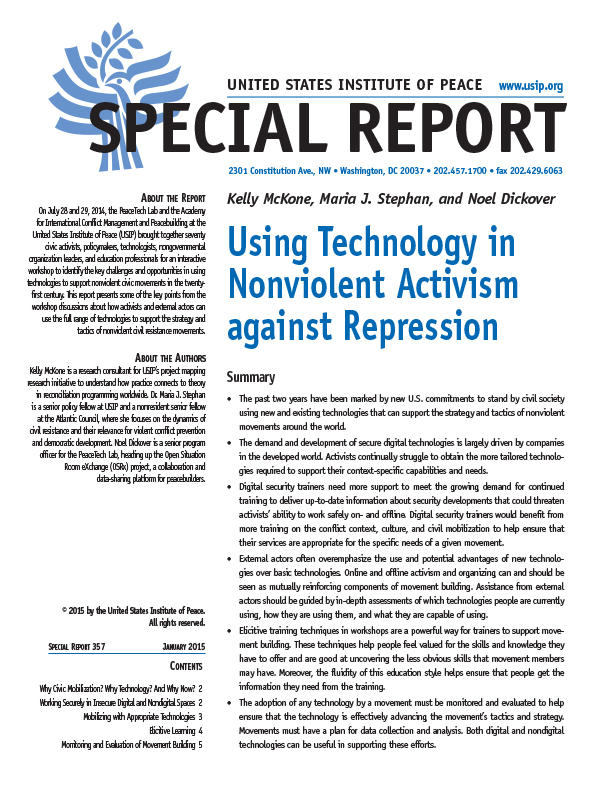In an era of crackdowns on freedoms of peaceful assembly and association, what role can technology play in strengthening nonviolent civic mobilization? How can activists strategically apply the full range of technologies to build and sustain movements where the options for nonviolently resolving conflicts are diminishing under increased repression? Informed by discussions from a USIP workshop, this report explores avenues for engagement between activists and external actors to use technology in support of movement building.
Summary
- The past two years have been marked by new U.S. commitments to stand by civil society using new and existing technologies that can support the strategy and tactics of nonviolent movements around the world.
- The demand and development of secure digital technologies is largely driven by companies in the developed world. Activists continually struggle to obtain the more tailored technologies required to support their context-specific capabilities and needs.
- Digital security trainers need more support to meet the growing demand for continued training to deliver up-to-date information about security developments that could threaten activists’ ability to work safely on- and offline. Digital security trainers would benefit from more training on the conflict context, culture, and civil mobilization to help ensure that their services are appropriate for the specific needs of a given movement.
- External actors often overemphasize the use and potential advantages of new technologies over basic technologies. Online and offline activism and organizing can and should be seen as mutually reinforcing components of movement building. Assistance from external actors should be guided by in-depth assessments of which technologies people are currently using, how they are using them, and what they are capable of using.
- Elicitive training techniques in workshops are a powerful way for trainers to support movement building. These techniques help people feel valued for the skills and knowledge they have to offer and are good at uncovering the less obvious skills that movement members may have. Moreover, the fluidity of this education style helps ensure that people get the information they need from the training.
- The adoption of any technology by a movement must be monitored and evaluated to help ensure that the technology is effectively advancing the movement’s tactics and strategy. Movements must have a plan for data collection and analysis. Both digital and nondigital technologies can be useful in supporting these efforts.
About the Report
On July 28 and 29, 2014, the PeaceTech Lab and the Academy for International Conflict Management and Peacebuilding at the United States Institute of Peace (USIP) brought together seventy civic activists, policymakers, technologists, nongovernmental organization leaders, and education professionals for an interactive workshop to identify the key challenges and opportunities in using technologies to support nonviolent civic movements in the twenty-first century. This report presents some of the key points from the workshop discussions about how activists and external actors can use the full range of technologies to support the strategy and tactics of nonviolent civil resistance movements.
About the Authors
Kelly McKone is a research consultant for USIP’s project mapping research initiative to understand how practice connects to theory in reconciliation programming worldwide. Dr. Maria J. Stephan is a senior policy fellow at USIP and a nonresident senior fellow at the Atlantic Council, where she focuses on the dynamics of civil resistance and their relevance for violent conflict prevention and democratic development. Noel Dickover is a senior program officer for the PeaceTech Lab, heading up the Open Situation Room eXchange (OSRx) project, a collaboration and data-sharing platform for peacebuilders.
